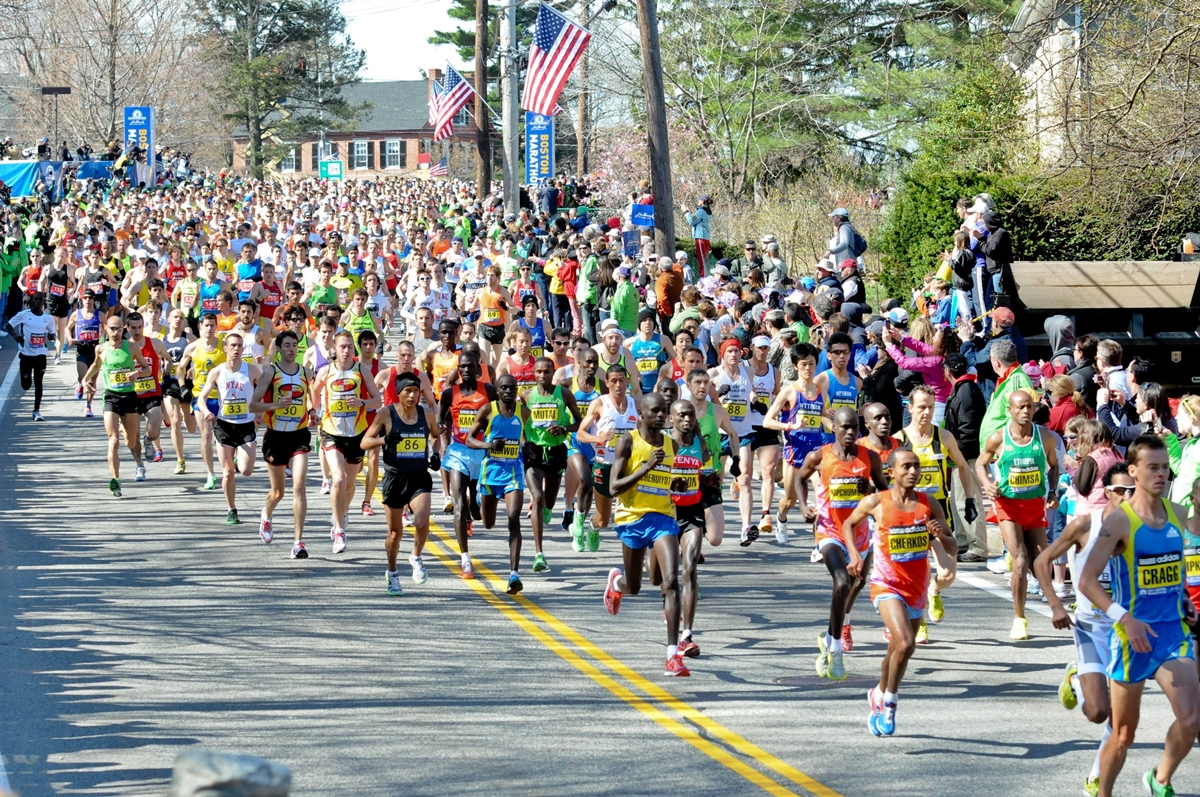

Featured
What Pace For A 2-Hour Half Marathon
Modified: January 22, 2024
Achieve your goal of running a 2 hour half marathon with our featured training plan. Find the optimal pace and strategy for success.
Introduction
Welcome to the exciting world of half marathon running! The half marathon is a popular event that offers a unique balance of challenge and accomplishment. As a runner, one of your primary goals may be to complete a half marathon in under two hours. Achieving this milestone requires dedication, proper training, and a strategic approach.
Running a sub-2 hour half marathon is no easy feat. It requires a combination of speed, endurance, and mental fortitude. However, with the right training plan and mindset, you can push your limits and reach your goal. In this article, we will discuss the factors that affect half marathon pace, how to set a realistic goal, and effective training strategies to help you achieve a sub-2 hour finish.
Before diving into the details, it’s important to note that every runner is unique, and pace can vary based on factors such as age, fitness level, experience, and terrain. Therefore, the strategies outlined here are general guidelines and may need to be adjusted according to your individual needs and preferences.
Now, let’s explore the factors that play a role in determining your half marathon pace and how you can prepare yourself for a sub-2 hour finish.
Factors Affecting Half Marathon Pace
Several factors can influence your half marathon pace and have an impact on your ability to achieve a sub-2 hour finish. Understanding these factors will help you make informed decisions regarding your training and race strategy.
1. Fitness Level: Your current fitness level plays a vital role in determining your half marathon pace. Generally, the more fit you are, the faster you’ll be able to run. Consistent training, including both endurance and speed workouts, is crucial for improving your fitness level.
2. Previous Running Experience: Your past running experience can also influence your half marathon pace. If you’ve been running for a while and have completed similar distance races, you may have a better understanding of your capabilities. However, even if you’re a beginner, with proper training and determination, you can still aim for a sub-2 hour finish.
3. Age: Age can have an impact on your half marathon pace. Generally, younger runners tend to have faster speeds compared to older runners. However, age should not deter you from setting ambitious goals. With age-appropriate training and consistent effort, age is just a number, and you can still achieve remarkable results.
4. Terrain and Course Difficulty: The terrain and course difficulty of the half marathon can significantly affect your pace. Hilly courses or challenging surfaces can slow you down, while flat and fast routes can help you maintain a quicker pace. When selecting a race, consider the course profile and its potential impact on your target time.
5. Weather Conditions: Weather conditions, such as heat, humidity, or strong winds, can impact your pace and race performance. Running in unfavorable conditions can make it more challenging to maintain your desired speed. Be aware of the weather forecast for your race day and adjust your strategy accordingly.
6. Mental Preparedness: Half marathon running requires mental strength and preparedness. Your mindset plays a crucial role in your ability to maintain pace and reach your goal. Developing strategies to stay focused, motivated, and positive during the race can significantly impact your overall performance.
By considering these factors and adapting your training and race strategy accordingly, you can increase your chances of achieving a sub-2 hour half marathon finish. In the next section, we will discuss how to set a realistic goal that aligns with your abilities and aspirations.
Setting a Realistic Goal
Setting a realistic goal is crucial when working towards a sub-2 hour half marathon. It’s important to assess your current fitness level, previous running experience, and commitment to training before determining your target pace. Here are some tips to help you set a realistic goal:
1. Assess Your Current Fitness Level: Take an honest evaluation of your fitness level and running ability. Look at your recent race times, long run distances, and overall running performance. Assessing your current fitness will help you understand where you stand and what level of improvement is necessary to achieve a sub-2 hour finish.
2. Consider Your Previous Running Experience: Reflect on past races and long runs to gauge your ability to maintain a consistent pace over distance. If you have completed previous half marathons, analyze your finishing times and how you felt during those races. This evaluation will give you valuable insights into your potential for improvement.
3. Consult with a Coach or Experienced Runner: Seek guidance from a running coach or experienced runner who can provide feedback on your abilities and help you set realistic goals. They can analyze your training routine, provide insights into your strengths and weaknesses, and suggest an appropriate target pace for a sub-2 hour finish.
4. Set Incremental Goals: Break down your ultimate goal of finishing under two hours into smaller, attainable milestones. This will help you stay motivated and track your progress. For example, aim to improve your 5K or 10K time first before focusing on the half marathon pace. Celebrate each milestone achieved along the way.
5. Be Aware of Your Time Constraints: Consider the time you have available for training and ensure it aligns with your goal. If you have a limited amount of time to train each week, it may be more realistic to set a more achievable goal initially and work towards a sub-2 hour finish in the future. It’s important to be realistic about the time and effort you can commit to your training.
6. Stay Flexible: Remember that goals can evolve as you progress in your training. Be open to adjusting your target pace based on your performance during training and any external factors that may affect your race day. Adaptability is key in setting a realistic and attainable goal.
By taking these factors into consideration and setting an achievable goal, you’ll be able to focus your training efforts effectively. In the next section, we will discuss training strategies specifically designed to help you achieve your sub-2 hour half marathon goal.
Training Strategy for a Sub-2 Hour Half Marathon
Training for a sub-2 hour half marathon requires a well-rounded approach that focuses on both speed and endurance. Here are some key training strategies to help you achieve your goal:
1. Follow a Structured Training Plan: Start by selecting a training plan that is designed to help you achieve a sub-2 hour half marathon. Look for plans that incorporate a mix of speed workouts, long runs, recovery days, and cross-training. Following a structured plan will ensure that you progress gradually and build the necessary endurance and speed.
2. Incorporate Long Runs: Long runs are an essential component of half marathon training. These runs help increase your endurance and prepare you mentally for the distance. Gradually increase the distance of your long runs, aiming to cover the full half marathon distance at least once before race day.
3. Implement Speed Workouts: Speed workouts, such as intervals, tempo runs, and fartleks, are crucial for improving your pace. These workouts train your body to run at a faster speed and help increase your lactate threshold. Incorporate one or two speed workouts per week to build your speed and improve your race pace.
4. Include Strength Training: Strength training is often overlooked but plays a significant role in enhancing your running performance. Incorporate exercises that target your core, legs, and upper body to build overall strength and prevent injuries. Aim for two to three strength training sessions per week.
5. Cross-Training: Cross-training activities like cycling, swimming, or yoga can complement your running routine and provide additional benefits. They help improve cardiovascular fitness, enhance flexibility, and give your body a break from the impact of running. Aim for one or two cross-training sessions per week.
6. Prioritize Recovery: Recovery is just as important as the training itself. Make sure to schedule rest days and include recovery activities such as foam rolling, stretching, and active rest. Proper rest and recovery allow your body to adapt to the training stimuli and reduce the risk of overuse injuries.
7. Monitor Your Progress: Keep track of your training and monitor your progress regularly. Use a running app or a training journal to record your workouts, noting your pace, distance, and how you felt during each session. This will help you identify areas of improvement and stay motivated as you see your progress unfold.
By following a well-designed training plan, incorporating speed workouts, building endurance, and prioritizing recovery, you’ll be on your way to achieving a sub-2 hour half marathon. In the next section, we will delve into specific strategies for improving your speed and pushing your limits even further.
Incorporating Speed Workouts
Speed workouts are a crucial component of training for a sub-2 hour half marathon. These workouts improve your running efficiency, increase your aerobic capacity, and help you maintain a faster pace. Here are some effective strategies for incorporating speed workouts into your training plan:
1. Interval Training: Interval training involves alternating between periods of high-intensity effort and recovery. For example, you can run at a faster pace for 400 meters and then recover with an easy jog for 200 meters. Repeat these intervals for a designated number of sets. Interval training helps to improve your speed endurance and increase your lactate threshold.
2. Tempo Runs: Tempo runs are sustained efforts at a comfortably hard pace. These workouts are typically done at a pace that is slightly faster than your goal half marathon pace. Start with a 10-15 minute warm-up, then maintain the tempo pace for a designated distance or time period (e.g., 3 miles or 20 minutes), and finish with a cool-down. Tempo runs improve your race pace and increase your aerobic capacity.
3. Fartlek Training: Fartlek, meaning “speed play” in Swedish, involves alternating between periods of fast running and easy jogging. During your run, pick landmarks ahead (e.g., lamppost, tree) and increase your pace until you reach them, then ease back into a comfortable pace. Fartlek workouts provide a mixture of speed and endurance training and can be adapted to suit your fitness level and environment.
4. Hill Repeats: Hill repeats involve sprinting up a hill at maximum effort and then jogging or walking back down for recovery. Repeat these hill sprints for a designated number of sets. Hill repeats improve your leg strength, power, and speed, making it easier to maintain a faster pace on flat terrains.
5. Track Workouts: Utilizing a track allows for precise measurement and repetition. You can incorporate various speed workouts such as 400-meter repeats, 800-meter repeats, or ladder workouts where you gradually increase the distance and then decrease it. Track workouts help improve your running economy and pace consistency.
6. Recovery and Adaptation: As speed workouts are demanding on your body, it’s crucial to incorporate adequate recovery days into your training plan. Allow for rest and easy runs to give your muscles time to repair and adapt to the training stimulus. Recovery enhances your performance and reduces the risk of overuse injuries.
Remember to warm up properly before speed workouts with dynamic stretches, and cool down afterward with static stretches to prevent muscle soreness and stiffness. Gradually increase the intensity and duration of your speed workouts as your fitness improves.
Incorporating a variety of speed workouts into your training regimen will enhance your running performance, increase your speed, and ultimately help you achieve your sub-2 hour half marathon goal. In the next section, we will explore strategies for building endurance and stamina to complement your speed work.
Building Endurance and Stamina
Building endurance and stamina is essential for successfully completing a sub-2 hour half marathon. It allows you to maintain a consistent pace throughout the race and prevent fatigue. Here are some effective strategies to help you build endurance and stamina:
1. Long Runs: Long runs are the cornerstone of endurance training. Gradually increase the distance of your long runs to build your aerobic capacity. Aim to cover the full half marathon distance at least once before race day. Incorporate a mix of easy-paced long runs and long runs with segments of faster-paced running to simulate race conditions.
2. Increase Mileage Gradually: Incrementally increase your weekly mileage to build endurance. Gradual mileage increases prevent overuse injuries and allow your body to adapt to the increased workload. Aim for a weekly mileage increase of no more than 10% to strike a balance between challenging yourself and giving your body adequate recovery time.
3. Consistent Training: Consistency is key when it comes to building endurance. Stick to your training plan and prioritize consistent running. Regularly scheduled runs, even on days when you don’t feel like it, will help condition your body and prepare you for the demands of a half marathon.
4. Cross-Training: Incorporate cross-training activities such as cycling, swimming, or using an elliptical machine to supplement your running. Cross-training allows you to engage in low-impact cardiovascular exercises, build overall endurance, and give your running muscles a break.
5. Negative Splits: Practice running negative splits during your training runs. Negative splits involve running the second half of your run faster than the first half. This technique helps condition your body to maintain a strong and steady pace even when fatigued, mirroring the second half of a race.
6. Tempo Runs: As mentioned earlier, tempo runs simulate race conditions and improve your endurance. They train you to sustain a faster pace over an extended period. Incorporate tempo runs into your training plan to improve your stamina and race-day performance.
7. Fueling and Hydration: Proper nutrition and hydration are integral to building endurance. Eat a well-balanced diet that includes carbohydrates, lean proteins, and healthy fats to provide the energy your body needs for long runs. Stay hydrated during your runs and practice fueling with gels or sports drinks to maintain energy levels.
8. Recovery and Rest: Building endurance requires proper recovery and rest. Allow for rest days and include active recovery activities like stretching, foam rolling, and light cross-training. Adequate rest allows your body to repair and adapt, preventing overtraining and injuries.
By implementing these strategies, you’ll gradually build your endurance and stamina, allowing you to maintain a consistent pace and complete your sub-2 hour half marathon. In the next section, we will explore the importance of race-day nutrition and provide tips to optimize your performance.
Perfecting Race-Day Nutrition
Race-day nutrition is an essential component of any half marathon training plan. The fuel you provide your body on race day can significantly impact your performance and help you achieve your sub-2 hour goal. Here are some tips to perfect your race-day nutrition:
1. Pre-Race Meal: Eat a balanced meal rich in carbohydrates the night before the race. Aim for a mix of complex carbohydrates, lean proteins, and healthy fats. This meal will provide your body with the necessary glycogen stores for endurance. Avoid trying new foods and stick to options that have worked well during your training.
2. Morning Fuel: On race day morning, have a light meal that is easily digestible and high in carbohydrates. Some popular options include a bagel with peanut butter, oatmeal with fruits, or a banana with some energy bars. Ideally, aim to eat about two hours before the race to give your body enough time to digest the food.
3. Hydration: Proper hydration is crucial on race day. Start hydrating the day before the race and continue drinking fluids leading up to the start time. During the race, drink water or sports drinks at aid stations to replenish fluids and electrolytes. Listen to your body’s thirst cues and drink accordingly.
4. Fueling During the Race: Practice using gels, energy chews, or sports drinks during your long training runs to determine what works best for you. Aim to consume carbohydrates during the race to maintain energy levels. Take small sips or bites of fuel at regular intervals to avoid stomach discomfort.
5. Practice Race-Day Nutrition: Train with your race-day nutrition plan during your longer training runs. This will help you identify what foods and hydration strategies work best for you and ensure that your body is properly fueled on race day. Consider the timing, quantity, and types of fuel you consume during these practice runs.
6. Post-Race Recovery: After the race, replenish your energy stores with a balanced meal that includes carbohydrates and proteins. This will aid in muscle repair and recovery. Also, don’t forget to hydrate, replacing any fluids lost during the race.
7. Listen to Your Body: Every runner is different, so listen to your body and adjust your nutrition strategy accordingly. Pay attention to any gastrointestinal discomfort during training and make adjustments to your race-day nutrition plan as needed.
8. Pack Your Own Supplies: If you have specific dietary preferences or requirements, consider bringing your own fuel and hydration supplies to ensure that you have exactly what you need on race day. This way, you won’t rely solely on the aid stations provided along the course.
Remember, race-day nutrition is not just about the one meal or snack you have before and during the race. It’s a culmination of proper nutrition throughout your training and consistent hydration practices. Perfecting your race-day nutrition will help optimize your performance and increase your chances of achieving a sub-2 hour half marathon.
In the next section, we will explore the importance of mental preparation and race strategies to help you stay focused and motivated on race day.
Mental Preparation and Race Strategies
Mental preparation and race strategies are key factors in achieving a sub-2 hour half marathon. Your mindset and approach to the race can greatly impact your performance and help you stay focused and motivated throughout. Here are some tips for mental preparation and effective race strategies:
1. Visualize Success: Before race day, spend time visualizing yourself crossing the finish line with a sub-2 hour time. Visualize the race course, the atmosphere, and how you will feel when you achieve your goal. Visualizing success helps build confidence and reinforces a positive mindset.
2. Set Milestone Goals: Break down the race into smaller milestones. Instead of focusing solely on the sub-2 hour finish, set milestone goals along the way. For example, aim to maintain a certain pace for the first few miles, then focus on maintaining that pace until the halfway point. Setting smaller goals can make the race feel more manageable and keep you motivated.
3. Develop a Race Strategy: Plan your race strategy ahead of time. Determine your target pace for each mile or kilometer and how you plan to achieve it. Consider factors such as course elevation, weather conditions, and how you respond to different sections of the race. Having a clear strategy will help you stay on track and confident during the race.
4. Stay Present and Positive: During the race, stay present and focused on each moment. Avoid dwelling on negative thoughts or distractions. Instead, cultivate a positive mindset by repeating affirmations or mantras that resonate with you. Focus on your form, breathing, and maintaining a steady pace.
5. Utilize Distraction Techniques: Use distraction techniques to keep your mind engaged and divert from fatigue or negative thoughts. Listen to music, podcasts, or audiobooks, or engage in positive self-talk. Focus on the scenery around you or observe and cheer on other runners. These distractions can help pass the time and boost your spirits.
6. Lean on Your Training: Trust in your training and the hard work you’ve put in leading up to the race. Remind yourself of the physical and mental strength you’ve developed throughout your training. Reflecting on your progress and believing in your abilities will boost your confidence and help you push through any challenges on race day.
7. Embrace the Race Environment: The energy and support of fellow runners and spectators can be a powerful motivator. Absorb the positive energy of the race environment and use it to fuel your determination. High-five spectators, thank volunteers, and draw inspiration from the camaraderie of the running community.
8. Stay Flexible: Despite thorough preparation, it’s important to stay flexible and adapt to unexpected circumstances. Be prepared to adjust your race strategy if needed, whether it’s due to weather conditions, a crowded race start, or any other factors that may arise. Stay calm, focus on what you can control, and make the necessary adjustments to keep moving forward.
Mental preparation and effective race strategies are as vital as physical training when it comes to achieving a sub-2 hour half marathon. Training your mind, setting milestone goals, developing a race strategy, and staying positive will help you stay focused and motivated throughout the race. In the next section, we will discuss common mistakes to avoid during your half marathon journey.
Avoiding Common Mistakes
When training for a sub-2 hour half marathon, it’s important to be aware of common mistakes that can hinder your progress and race day performance. By avoiding these mistakes, you can optimize your training and increase your chances of achieving your goal. Here are some common mistakes to steer clear of:
1. Neglecting Recovery: Proper recovery is vital for injury prevention and performance improvement. Neglecting rest days and recovery practices can lead to overtraining, fatigue, and increased risk of injuries. Make sure to incorporate rest days, active recovery, and adequate sleep into your training plan.
2. Skipping Strength Training: Strength training is often overlooked by runners, but it plays a crucial role in injury prevention and improving overall performance. Neglecting strength training can lead to imbalances, weak muscles, and decreased running efficiency. Include regular strength workouts that target your core, legs, and upper body to build strength and endurance.
3. Ignoring the Importance of Cross-Training: Cross-training activities, such as cycling, swimming, or yoga, are beneficial for both physical and mental conditioning. They provide a break from running while still improving cardiovascular fitness, flexibility, and strength. Neglecting cross-training can lead to burnout, overuse injuries, and decreased performance.
4. Overemphasizing Quantity over Quality: While it’s important to gradually increase your mileage and training volume, it’s equally important to focus on the quality of your workouts. Don’t get caught up in simply running more miles without purpose. Incorporate speed workouts, tempo runs, and other targeted training sessions to improve your pace and endurance.
5. Inconsistent Training: Consistency is key in half marathon training. Irregular training, missing scheduled runs, or not following a structured plan can hinder your progress. Aim to be consistent with your training, making time for regular runs and other training components. Consistency will help build your fitness level, improve your running efficiency, and develop mental resilience.
6. Failing to Adjust Goals and Expectations: While aiming for a sub-2 hour half marathon is a worthy goal, it’s important to remain flexible and adjust your goals and expectations as needed. External factors such as weather conditions, injury setbacks, or life circumstances may require you to modify your target time. Be open to adjusting your goals while still challenging yourself.
7. Ignoring the Importance of Nutrition: Nutrition plays a crucial role in fueling your training and optimizing your performance. Neglecting proper nutrition can lead to decreased energy levels, poor recovery, and suboptimal race day performance. Aim to eat a balanced diet with a focus on whole foods, stay hydrated, and practice race-day nutrition strategies during your training runs.
8. Lacking Mental Preparation: Mental preparation is often overlooked but essential for success in a sub-2 hour half marathon. Failing to train your mind and develop mental strategies can lead to self-doubt, negative thinking, and decreased motivation. Incorporate mental preparation techniques such as positive affirmations, visualization, and staying present during training and on race day.
Avoiding these common mistakes will help you stay on track and optimize your training for a sub-2 hour half marathon. By prioritizing recovery, strength training, cross-training, consistent training, adjusting goals when necessary, proper nutrition, and mental preparation, you’ll be better equipped to reach your goal. In the next section, we will conclude with a summary of the key takeaways from this article.
Conclusion
Training for a sub-2 hour half marathon is a challenging yet rewarding endeavor. By understanding the factors that affect your pace, setting realistic goals, following a well-rounded training plan, and implementing effective race strategies, you can increase your chances of achieving your goal. Avoiding common mistakes such as neglecting recovery, skipping strength training, and lacking mental preparation will further optimize your performance.
Remember to prioritize both physical and mental aspects of your training. Building endurance, incorporating speed workouts, perfecting race-day nutrition, and developing mental toughness are critical steps in achieving a sub-2 hour half marathon. It is important to stay consistent, focused, and flexible throughout your journey.
While the sub-2 hour goal may seem challenging, with dedication, perseverance, and a strategic approach, you can conquer it. Embrace the process, enjoy the journey, and celebrate every milestone along the way. Your hard work and determination will pay off as you cross that finish line, achieving your sub-2 hour half marathon and experiencing the immense sense of accomplishment that comes with it.
Now, take this knowledge, lace up your running shoes, and embark on your training journey towards that sub-2 hour half marathon. Believe in yourself, stay focused, embrace the challenges, and enjoy the fulfilling experience of pushing your limits and achieving your running goals.









